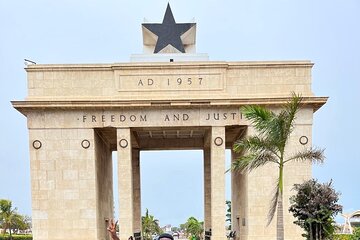3 Days Accra City Tour & Cape Coast Tour
Share this tour

Offered languages
- German
- German
- English
- English
- English
- Italian
- Italian
- French
- French
- French
- Spanish
- Spanish
This 3-day tour offers a dynamic blend of urban exploration and rich historical experiences. On the first day, you’ll discover the vibrant city of Accra, with its lively markets, cultural landmarks, and bustling atmosphere. The next two days will be dedicated to Cape Coast, where you’ll delve into the region’s profound history, including visits to its renowned castles, stunning beaches, and serene natural attractions.
What's Included
Lunch
Breakfast
Meeting and pickup
Itinerary
-
1
Asomdwe Park is the venue which holds the mortal remains of the Late Former President J.E.A Mills ... It is a serene environment and a recommendable place for tourists... It also like a mini zoo for some animals like the ostrich, fishes and birds
30 minutes • Admission ticket included -
2Independence Square
The Independence Arch in Accra, Ghana, is part of the Independence Square which contains monuments to Ghana's independence struggle, including the Independence Arch, Black Star Gate, and the Liberation Day Monument
40 minutes • Admission ticket included -
3Centre for National Culture, Accra
The museum houses a fascinating collection of Ghana’s historical treasures. The exhibits housed under the two-tiered rotunda of the museum comprise much more than Ghanaian Culture alone, and include a collection of the neighbouring West African countries as well.
40 minutes • Admission ticket included -
4Kakum National Park
This park makes for a great day hike with fantastic views, especially from the wooden suspension bridges that soar a hundred feet overhead. The Kakum Canopy Walk allows hikers to experience a portion of the jungle usually reserved for climbers and fliers thanks to a trail of precariously hung suspension bridges.
1 hour • Admission ticket included -
5Assin Manso Ancestral Slave River Park
Assin Manso was the final link in the slavery route from northern Ghana, and it was known to have been the largest slave market for merchants supplying slaves to the forts and castles along the coast. Former slaves from the Americas, Samuel Carson from the USA & Crystal from Jamaica, were re-interred here in 1998. In addition to the cemetery, the Slave River can be visited as well. This is now a sacred place of remembrance. Slaves that were brought from northern Ghana and were washed and sorted before selling them to the merchants. The river where the slaves washed themselves is called ‘NNONKO NSUO’ meaning Slave River. After sorting, the fit ones were sent to the forts along the coast, where they were locked up in cells for months before “shipment” across the Atlantic, to an unknown place and future
1 hour • Admission ticket included -
6Cape Coast Castle
Cape Coast Castle served as one of the slave castles built on the shores of Ghana. It also served as the Administration center for British rule in West Africa. Participants will visit the museum and dungeons where slaves were kept while awaiting shipping to the New World.
45 minutes • Admission ticket included -
7Elmina
Elmina is the first European trading post built on the Gulf of Guinea and claimed to be the oldest European building South of the Sahara. It was founded by Portugal in 1482, taken over by the Dutch in the 17th century and by Britain in the late 19th century. Elmina Castle and other forts and castles along the Gold Coast protected important ports of the European-African Gold and Ivory trade and became later centres of the trans-Atlantic Slave trade. Elmina Castle, together with 17 other fortified trading-posts in Ghana is inscribed as “Forts and Castles, Volta, Greater Accra, Central and Western Regions in the UNESCO World Heritage List.
45 minutes • Admission ticket free
ACCRA CITY TOUR
Cape Coast Tour (The Slave History)
Cape Coast Tour
Additional info
- Specialized infant seats are available
- Not recommended for travelers with spinal injuries
- Not recommended for pregnant travelers
- Not recommended for travelers with poor cardiovascular health
- Suitable for all physical fitness levels
Tags
Cancellation Policy
For a full refund, cancel at least 24 hours before the scheduled departure time.
Show more
Cancellation Policy
- For a full refund, you must cancel at least 24 hours before the experience’s start time.
- If you cancel less than 24 hours before the experience’s start time, the amount you paid will not be refunded.
- Any changes made less than 24 hours before the experience’s start time will not be accepted.
Rating
You can cancel up to 24 hours in advance of the experience for a full refund.
Your guide to the flawless travel experience











